Wind Power
Wind power was the first of the second generation renewables to become cheaper than coal, and as a result its popularity has absolutely exploded in the last 15 years. British Columbia has many excellent locations for wind farms, but wind power expansion has been slow compared to some other provinces and some other countries.
Wind Power
By the Numbers
40 x
Number of times over that wind power could supply all the world's electricity
2 Megawatts
Generating capacity of today's average wind turbine
1,200
Number of 2 MW wind turbines needed to replace 1,000 MW of coal or gas fired power
42%
of all electricity in Denmark provided by wind power
486 Gigawatts
Worth of wind farms in operation around the world by 2016
2,700%
Increase in total wind capacity between 2000 and 2016
Last Updated: February 2017
Humans have harnessed wind power for thousands of years, using sails to propel ships and windmills to pump water. It has, however, only been in the past 40 years that wind has been viewed as a viable way to generate electricity on a grand scale.
The appeal of deriving power from the wind is obvious: the wind is free, inexhaustible, and always blowing somewhere. The modern wind turbine, pioneered by American and Danish companies following the oil shocks of the 1970s, employed the tried and true angled propeller used by aircraft, to catch the wind, spin, and then use the rotational motion to drive an electric generator. Although other designs exist, the propeller-based Horizontal-Axis Wind Turbine (HAWT) is the one most commonly associated with wind power. Its primacy has been cemented in recent years by its continued technological development.
Like all second generation renewable energy technologies, wind power technology developed slowly through the 1980s and into the 1990s. In the past fifteen years however wind has become the first of these new technologies to reach economic competitiveness with fossil-fuel based forms of electricity generation. As a result, worldwide interest has surged. Generating capacity exploded from 6.1 gigawatts in 1996 to 468 gigawatts in 2016, so that now wind produces over 3% of the world's electricity. Ninety-eight percent of these wind farms are onshore as offshore wind farms are not quite as economically competitive.
Denmark, one of the world leader in wind power, already gets approximately 42% of its electricity from wind turbines, both onshore and offshore. Wind power is expected to continue growing for at least another decade alongside other renewables, such as solar. Canada has been moving up the leader table in wind power in recent years, and now has the 7th most installed capacity, 2.6% of the world’s total wind turbines. Plans for the continued development of wind farms are on the board in all the provinces and territories, with Ontario and Quebec leading the way. B.C. was the last province to take to wind power, but its geography makes it well-suited for wind power generation; with long coastlines, large plains and mountains generating high wind speeds. Four wind farms have been built since 2009 and a fifth, the largest, is currently under construction.
Wind does face many challenges. Even though wind turbines are massive, standing hundreds of metres tall, they only generate a comparatively small amount of energy: The typical turbine being built right now has a name-plate capacity of a mere 2 MW, but they are growing. The problem of irregular windiness and periods of no wind is known as intermittency and it brings the 2 MW generating capacity closer to 0.6-0.8 MW. That means in order to completely replace a single 1,000 MW coal power plant, over 1,200 2 MW wind turbines will have to be built, a considerable industrial undertaking.
Residents living near proposed wind farms often oppose them on visual grounds, or because of the irritating swishing noise they make. Some commentators claim the high and low frequency noises made by the turbines can cause a range of health problems, even cancer. Numerous studies have found these concerns to be unfounded. In at least one case the idea of wind turbine syndrome has been promoted by fossil fuel lobbying groups. The swiftly rotating blades have also been known to kill birds, though studies show this issue has also been overblown and is mostly linked to older and now obsolete wind farm designs.
Wind farm developers are rapidly improving the integration of wind-based electricity into the power grid. Progress is being made in terms of development, improved efficiency of turbines and getting locals on board with installation in public areas.
As a result many governments are putting their faith in wind power. Germany, the USA, France, India and Turkey all installed over 1,000 MW of wind power in 2016. China, has invested enormously in wind and is now the world leader and as of 2016 a third of all the world’s wind turbines are in China. In 2010 they announced an ambitious plan to install 100 GW of wind capacity by 2020. Instead they've rocketed past that target, hitting 168 GW by the end of 2016. The field of wind energy is moving extremely rapidly and growing in leaps and bounds. Because of this wind is likely to play an increasingly prominent role in our energy economy.
- Global Wind Energy Council, “Global Installed Wind Power Capacity (MW).” 2016.
- Global Wind Energy Council, “Wind in Numbers.” 2015.
- Krohn, 2009.
- Jacobsen, 2016.
- Global Wind Energy Council, “Global Installed Wind Power Capacity (MW).” 2016.
- Wikipedia, “List of wind farms in Canada.”
- Renewable Energy Source, "Debate on The Wind Energy Challenge."
- Global Wind Energy Council, “Global Wind Statistics 2016.”
How Wind Power Works
- Winds are caused by the sun's heating of the earth, and the earth's rotation.
- 90% of the world's turbines are the Horizontal Axis Wind Turbine design (HAWT) and have a big propeller.
- 10% of wind turbines are Vertical Axis Wind Turbines (VAWT) that come in many designs and good in built up areas.
- Small wind turbines can be purchased individually and are popular in some rural areas.
The Wind
The winds that travel around the earth have two different driving mechanisms. The first mechanism is uneven heating of the earth by the sun: equatorial latitudes receive more of the Sun's rays than the polar latitudes. The differential heating of the earth leads to variations in atmospheric pressure; wind is simply the rush of atmospheric gases from high pressure areas to low pressure areas. In this sense wind power is actually another form of solar power. The second mechanism is the rotation of the earth, which, through the Coriolis Effect, causes air to be deflected from the north-south wind patterns and creates winds that blow east and west. At high altitudes winds caused by these two forces are quite constant but lower to the earth's surface the topography (ie. mountains and oceans) distorts the winds and causes it to move in more complicated patterns.
Horizontal-Axis Wind Turbines
There are two main designs of wind turbines that capture the wind's energy. The basic, most commonly used wind turbine, the Horizontal Axis Wind Turbine (HAWT) is rather simple, using large angled propeller blades to catch the wind. When the wind passes through the blades, it causes the entire blade assembly, known as a rotor, to spin around a central nacelle atop a tall tower. Inside the nacelle is housed a gearbox which converts the low-speed incoming rotational force into high-speed outgoing rotational force, powerful enough to run an electrical generator also housed in the nacelle.
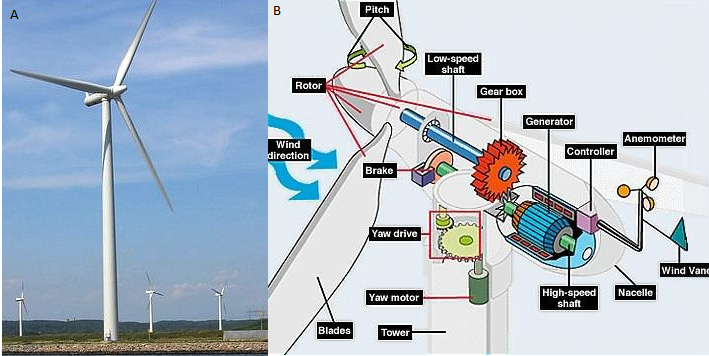
Metaefficient: Guide to Efficient Living
Modern wind turbines employ a number of refinements that make them safer and more efficient than their predecessors just 20 years ago. The nacelles on most HAWT turbines can be controlled to face into the wind where they will have the greatest efficiency. On small turbines this can be done with an anemometer, while at large wind farms more elaborate computer-controlled systems are used. In stormy conditions, when winds are extremely high, the rotor can be damaged, and the blades are faced perpendicular to the wind in order to keep them from spinning out of control. Brakes can also be employed to keep the blades from spinning too fast.
Many of the newest utility-grade wind turbines are very tall. That way they can access the winds higher off the ground, which are stronger and more constant. They also have longer blades, increasing efficiency through a larger area interacting with the wind. The most common 2 MW turbine is usually between 40 to 60 metres tall. They are getting bigger and more powerful though: The most powerful wind turbine in the world, the Vestas V164, just entered production in Denmark. At 220 metres it’s as tall as a 62-storey building. 7 MW turbines built by Siemens are likely to become the standard for offshore farms in the near future. A number of wind turbine manufacturers around the world are racing to build the turbines bigger, with 10 and 20 MW designs in the pipeline.
Vertical-Axis Wind Turbines
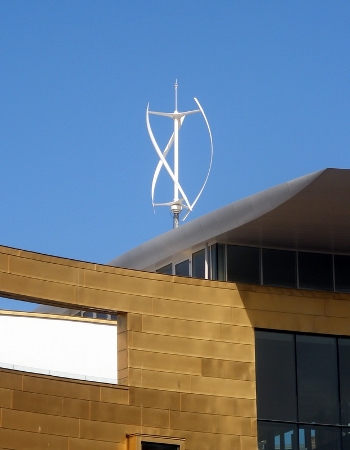
Energy Insight
There is another wind turbine design that has been developed alongside the HAWT: the Vertical-Axis Wind Turbine (VAWT). Though comprising only about 10% of modern wind turbines currently in operation, there are a wider variety of VAWT designs. The designs include the Darrieus, Giromill and Savonius turbines. They all work on the same basic principle: the rotors spin around a central vertical tower, generating power for the gearbox and generator located at the base of the tower.
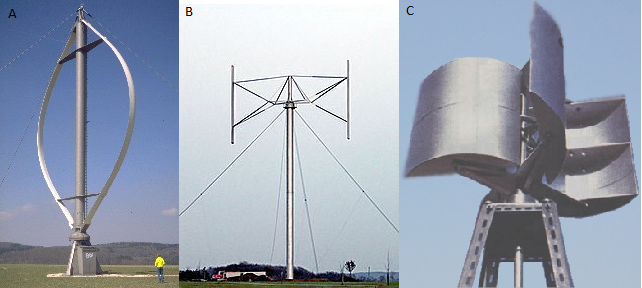
REUK.co.uk
The disadvantages of VAWTs are the reason they have such a small market share. Generally VAWTs are less efficient than the HAWTs since, as they are placed perpendicular to the wind, when one side is being blown by the wind, the other is moving in the opposite direction against the wind. As a result the power coefficient of modern VAWTs average 0.3-0.4, while the newest HAWTs have an efficiency of 0.5. Since they are not usually placed on towers and are closer to the ground, they don't access the higher more constant winds that HAWTs tap into. The more powerful centrifugal forces acting on the eggbeater-like blades on Darrieus wind turbines also put more stress on the blades and can cause them to bend or break.
Small Scale Wind Turbines
There are also smaller scale wind turbines available. These turbines can be set up for individual household, rural or agricultural use. The cost of residential wind turbines has decreased substantially since the 1980s and the turbines have become more efficient. Small scale wind turbines generate a tiny, but growing, portion of the renewable energy market.
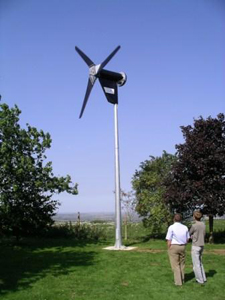
TV Energy
Small scale wind turbines are mainly horizontal axis wind turbines but there are small scale vertical axis wind turbines as well. Most small scale wind turbines are less than 25 metres tall and have rapidly rotating blades. Some of these turbines are put on rooftops. Some turbines also have vanes that will point them into the wind to increase their efficiency. Small wind turbines can be purchased for as little as $800.
Until 2012 Saskatchewan’s SaskPower offered rebates to customers who installed small wind turbines or solar panels on their homes which were net-metered to the grid. The small turbines produced far less power than was expected, a disappointing result. This was likely because the vast majority of these small turbines were HAWTs which were likely not high enough off the ground and highly sensitive to the turbulence of nearby buildings or hills. Small VAWTs would likely have worked much better in these conditions, though solar panels were also shown to be far and away a better investment in the local market.
Geography of Wind Power
- Wind farms are most efficient where the winds are strong and constant.
- Places with an Annual Mean Wind Speed (AMWS) of around 15 metres per second are best.
- Local opposition, proximity to transmission lines, pre-existing roads, and mountainous terrain are all important considerations for siting a wind farm.
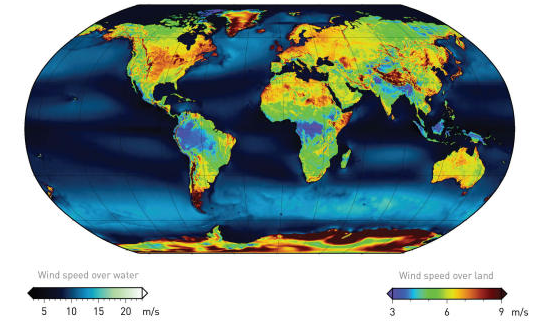
Oracle Education Foundation
Efficient wind farms obviously require strong and constant winds. There are four main factors that affect the winds and allow engineers to accurately predict which places will be the best sites for wind farms. The first is pressure gradient which is generated by differences in atmospheric pressure between two adjacent areas. The second is frictional force which is increased by features on the earth's surface such as trees and mountains. The third factor is the Coriolis Effect which deflects the direction of wind flow on the earth's surface. Finally, elevation plays a major role in wind speed as there are fewer obstacles at higher elevation to block wind creating higher wind speed.
These factors make certain sites particularly well suited for wind farm development. Some of the best sites for wind turbines are in mountainous areas, such as the Rocky and Appalachian Mountains. Wide open plains such as Tornado Alley and the open ocean are also great for wind power.
The suitability of a site can be determined by measuring the Annual Mean Wind Speed (AMWS). From this number can be derived the expected capacity factor at a given site over the year and therefore how many MWh can be expected to be produced.
In practice only the most efficient wind turbines, which are just entering the market today, can reach capacity factors above 40%. Wind developers will ideally aim to develop sites with capacity factors above 35%, meaning sites with winds upwards of 5 m/s and to a maximum of 25 m/s.
Other factors must be considered when choosing a site for a wind turbine. For instance, at what times of day and what times of year is the wind most likely to blow? Finding a site where the winds coincide with times of highest electricity demand is helpful in integrating wind energy into the power grid. In most jurisdictions, power use peaks in the late afternoon and evening. In British Columbia people are far more likely to desire home heating during winter, rather than air-conditioning in the summer.
People often object to wind farms near their homes, resulting in protracted permitting processes and legal battles. To expedite the process wind developers seek to build away from densely populated areas.
There are a few other considerations. To keep down costs it is also helpful to find sites that are not difficult to access, such as places where logging or mine roads already exist. Wind turbines are expensive to erect and maintain on mountain slopes, and mountain winds contribute to wind shear which has the potential to damage the rotor blades, thus ruling out much of British Columbia.
Finally, it is helpful to find sites that are in close proximity to existing transmission lines, as the building of new transmission lines can add significantly to costs. This is especially the case for offshore wind farms and has contributed to the slower development of that sector.
Meeting all of these requirements considerably narrows down the number of potential sites for wind farms. British Columbia is mountainous, with many areas that are hard to access or with populations who object to having wind turbines in plain sight. This can offer part of the explanation of British Columbia’s early lag behind the other provinces in developing its wind capacity.

BC Hydro
Economics of Wind Power
- Wind power is the first second generation renewable technology to become cost competitive with fossil fuels.
- The cost of wind power has dropped 95% over the last 30 years.
- In many places wind power is now cheaper than coal and some types of gas power generation.
- Offshore wind farms are more expensive, but they are more efficient and will become more popular as the price drops.
How well does wind stack up against the other energy sources economically? Onshore wind is already cost competitive with coal and even gas and becoming cheaper all the time, while offshore wind is quickly catching up.
Wind power is a domestic power source, requiring no energy imports from potentially unstable regions, nor is the fuel subject to price fluctuations. However, the price of wind energy can vary significantly depending on the location of the wind farm and the consistency of the wind. A 2015 U.S. Energy Information Administration report compared expected prices of electricity from different plants built in 2020.
MAKE GRAPH https://en.wikipedia.org/wiki/Cost_of_electricity_by_source
Wind came out essentially the cheapest, save geothermal, tying the most efficient type of natural gas plant and massively beating coal or hydro. Even this report might hugely overstate the expense of wind power—the Advanced Energy Economy Institute criticized the report for putting wind prices so high. They point to a Department of Energy report that showed wind prices had already fallen to a jaw-droppingly low $23.5 MWh nationwide.
Even without the support of massive subsidies, wind energy is becoming cheaper than coal. This is a major development and today most of the countries that have relied the most on coal for their electricity are the ones now investing most heavily in wind (China, USA, Germany, India). China has reached the upper limit of the amount of coal it can produce without rapidly exhausting its supplies. It's no coincidence that they are now the world's biggest producers of wind energy. Denmark and Germany used to rely on poor quality lignite coal for their power, but high percentages of their electricity now comes from wind. Ontario is phasing out all of its coal power plants and building wind farms. All these changes only began happening after wind became cost-competitive with coal. The lesson here is that economic competitiveness is key for any renewable energy to catch on.
The Costs behind Onshore Wind
For onshore wind about 75% of the costs are up-front one-time costs just to get the turbines up and running, making it very capital intensive. Of that share, three quarters is for construction of the turbines and another 9% for the transmission lines connecting them to the power grid. The remainder goes to building foundations and access roads, and paying rent to landowners. Once the wind farm is built the final 25% of costs all go into routine maintenance, spare parts, and the eventual decommissioning of the turbines 20 years later.

Paul Anderson
Wind power wasn't always as competitive as it is today: continuous technological innovations and the development of an economy of scale have meant that the price of wind energy has dropped 90-95% since the first wind farms came online in 1980. Wind power's new-found status is instructive in the importance of sustained technological innovation and the economics of scale. Offshore wind energy has been declining in price but not reached the same level as onshore wind. If the past trends are any indicator we can reasonably conclude that offshore wind will eventually become cost-competitive.
The High Price of Offshore Wind
Future development of wind power is looking to move offshore where winds are stronger and more constant. Offshore farms average 4,000 hours per year of full-load generation, as opposed to 2,000-2,500 for onshore. The turbines can be much bigger, and most of the 7 MW and up mega-turbines currently in development are slated for deployment offshore. Furthermore they can solve the NIMBY problem as wind turbines installed at least 11 km offshore are hidden by the curvature of the earth.
Despite these advantages offshore wind is still in its infancy: As of 2014 there were 84 offshore wind farms around the world, all in Northern Europe, comprising 2% of global installed wind capacity.
The problem lies in an offshore wind farms different cost structure. As the Wall Street Journal reported, "Offshore, turbines only make up one-third of the project cost, says the U.S. National Renewable Energy Laboratory. About 25% of the cost comes from the platform to hold the turbine up, 24% from increased maintenance costs, and fully 15% from building new undersea transmission lines."
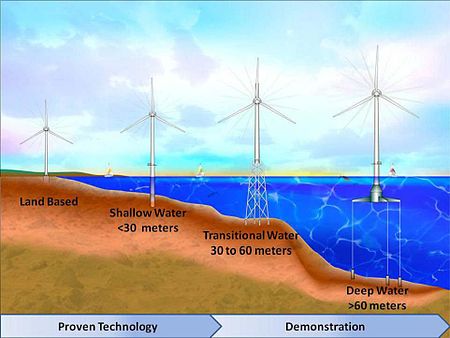
National Renewable Energy Laboratory
The turbines used for offshore are larger, and cost about 20% more than their onshore counterparts, while the foundation and transmission lines cost 2.5 times as much as a comparable onshore development, though they can generate twice the amount of energy.
There are also different environmental factors to consider in an offshore wind farm, such as salt build up on blades, increased corrosion of the structure from salt water and battering by storms. Nevertheless the world has tremendous potential for offshore wind development, and as the technology matures and the economics improve we can expect to see a surge in offshore wind development.
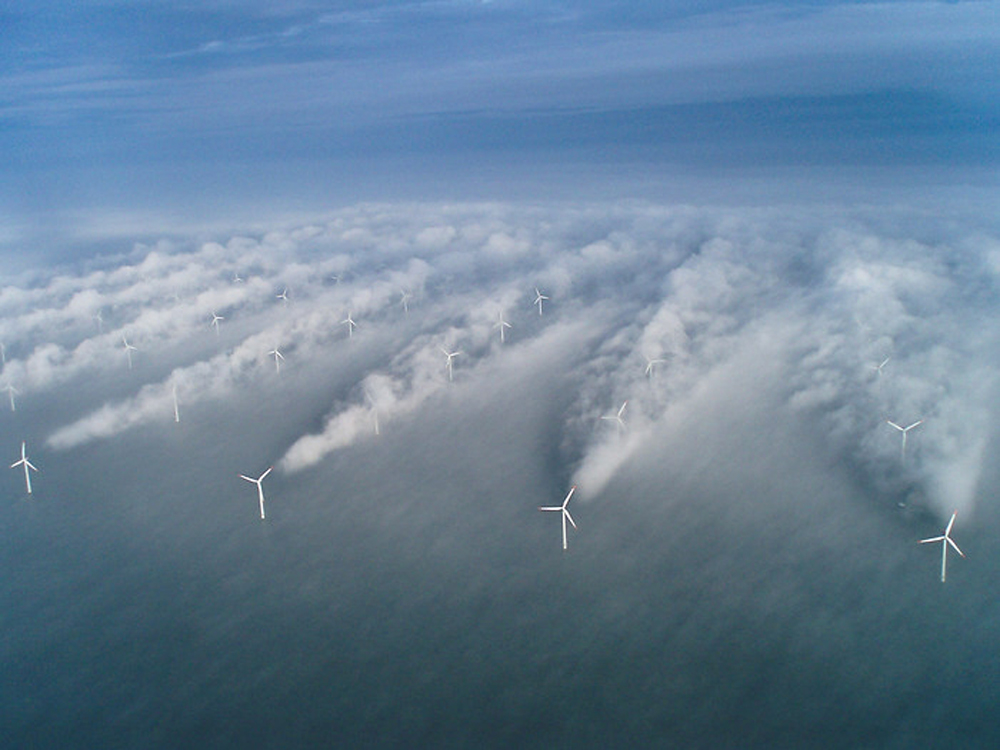
NOAA
Environmental and Social Issues
- A vocal minority of people oppose wind farms near their homes.
- Some people believe that wind turbines cause negative health effects, but there is no scientific evidence to support this belief.
- There is widespread belief that wind farms pose a unique danger to birds, but studies show this fear is wildly overblown.
- Wind power produces fewer carbon emissions than practically any other form of energy.
- Since each turbine only produces a relatively small amount of energy, major market penetration will require building thousands of turbines.
Opposition to wind farms from local residents is one of the biggest hurdles an expansion of wind power faces. Though wind power is the most popular alternative energy today, intense and directed lobbying from NIMBY groups has managed to stall and force the cancellation of many projects. Polling however indicates that the silent majority of people, at least in some areas, support wind farms within sight of their homes. Educating the public about the validity (or lack thereof) of the alleged health effects, and creating consensus on the use of wind power, will be essential for determining the future of wind power.
Not In My Back Yard
One intensely debated aspect of wind energy is NIMBYism—which stands for Not In My Back Yard. It is a term used to describe people who may support an idea like renewable energy in principle, but are opposed to developments happening near where they live. With wind energy this most commonly manifests itself in complaints about the way wind turbines impact the landscape visually, and with the noise they create.
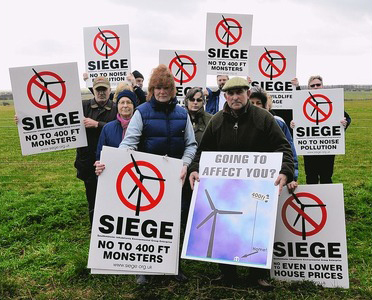
Renew Economy
Since wind turbines can stand several hundred meters tall, and they are grouped together into farms, their visual impact on a landscape can be large. In this context one essay writer describes the two differing reactions people have to the visual impact wind farms have on a landscape.
One finds the sight of the wind farm beautiful in a very deep, heartfelt sense, and if you ask her, she'll say that the perception is intimately connected, even shaped by, her understanding of the larger ecological context of energy. The other literally recoils from the sight of the wind farm, as an ugly, even offensive blemish on the wondrous, untouched naturalness of the vista.
The point is not whether or not one of these views are right, but that many people who live near wind farms developments take the latter view.
Wind Turbine Syndrome
The second major issue of concern to local residents is the noise created by wind turbines, both low frequency and therefore inaudible to humans, and high frequency which is audible. One doctor Nina Pierpont, coined the term Wind Term Syndrome to describe negative health effects experienced by some living near the turbines that she blamed on the low-frequency noise. The symptoms described in her book included migraines, high-blood pressure, ringing in the ears and other stress related illnesses. Pierpont’s book has been criticized as deeply flawed, lacking in scientific rigour and prone to a number of biases, but it has become a standard talking point amongst those opposed to wind farm development.
Fully 18 scientific studies have carefully examined Pierpont's claims and found that wind turbine syndrome, when it’s not simply fabricated, is a psychosomatic response to anxiety felt by those who really dislike wind turbines. One study in Australia found that health complaints related to wind farms only appeared after anti-wind lobbying groups began including wind turbine syndrome in their talking points, and the symptoms only occurred in the communities they targeted, not in those where anti-wind farm activists had not been lobbying. Australia’s most prominent promoter of the dangers of 'wind turbine syndrome' is the Waubra Foundation, which has well documented ties to Australian coal utilities.
Epsilon Associates, an acoustic consulting firm, studied low-frequency noise effects and have concluded that though early American wind turbine designs (that is, over a decade old) did create low frequency noise which could potentially lead to health problems, all new models that employ sound-dampeners do not. The study concluded "wind turbines at maximum noise at a distance more than 1,000 feet from a residence do not pose a low frequency noise or infrasound problem." At this distance wind turbines met all low frequency noise regulations, including the most stringent ones set out for classrooms and hospitals.
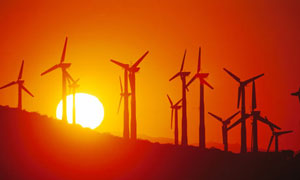
The sun sets behind a wind farm. One complaint from people living near wind farms is that at dawn or dusk the day the blades can cause pass in front of the sun, causing an irritating flashing for a few minutes. Wind engineers work now to site farms in such a way as to prevent this occurring.
Fiji One
Despite the widespread media attention to the supposed health impacts of wind power, there remains no peer-reviewed evidence that "wind-turbine syndrome" exists. The term "wind turbine syndrome" does not appear in any medical literature anywhere.
Power of NIMBY
Concerns about the aesthetics of wind, and the (largely debunked) health impacts, have helped contribute to a groundswell of opposition to wind farm development. In Canada and around the world, ambitious policies to expand wind power are running into fierce opposition. Studies show that people support wind power in principle above all other forms of energy generation. That support can become more muted, or downright hostile, when people find out they are going to be living near a wind farm.
The most widely-reported case of NIMBYism around wind energy is the Cape Wind project, America's first proposed offshore wind farm in Nantucket Sound. In 2001 it was proposed to build 130 turbines between 6 and 17 km offshore with a maximum generating capacity of 454 MW.
Immediately some local residents objected and formed the Alliance to Protect Nantucket Sound, seeking to derail the project. The region is a vacation location for many of America's most powerful families and for once America's political class, both Democrat and Republican, stood united in their opposition to America's first offshore wind farm. The Alliance received the support and money of the Kennedys, Secretary of State John Kerry, Republican Governor Mitt Romney and oil and coal magnate Bill Koch.
Robert Kennedy Jr. wrote an op-ed for the New York Times in 2005 that could be said to encapsulate the NIMBY position. Opening with "As an environmentalist, I support wind power, including wind power on the high seas," he then argued that the farm's "Hundreds of flashing lights to warn airplanes away from the turbines will steal the stars and nighttime views." That the spoilt views, Kennedy continued, would cost "up to 2,533 jobs because of the loss of tourism - and over a billion dollars to the local economy."
Polls taken in 2007, after the project had been hotly debated for six years without a decision on the matter showed that a majority of the state's population (84%) and local residents (58%) supported the Cape Wind Farm. Despite this support continual lawsuits and legislative maneuvering has meant the project has yet to begin construction a decade later. Though the project received the federal government's go-ahead in April 2011 as of spring 2016, fully 15 years after it was first proposed, the project has yet to be built.
Though many commentators argue that the power and influence of those opposed to Cape Wind are an exceptional case of NIMBYism, this opposition is often hugely effective and has had an enormous impact on the development of clean energy sources around the world. One 2011 study by the U.S. Chamber of Commerce found that fully 45% of clean energy projects had been scrapped because of NIMBY opposition.
Canada's own local NIMBY activists have forced the scuttling of several wind farm developments. Over 51 Not In My Back Yard anti-wind farm groups have sprung up in Canada in the last decade. Ontario wind developers have scrapped at least three wind farm proposals in the past few years because of pressure from these groups. Hearing these concerns in an election year, the Ontario government put a surprise moratorium on offshore wind farms until further research was done on their health impacts. "On-shore, there is 30 or 40 years of peer-reviewed science ... there's no evidence of health impacts from onshore wind, but offshore wind is completely different," said then Ontario Energy Minister Brad Duguid. 59He failed to explain how the health impacts may differ. Wind farms are not required to undergo a full environmental impact assessment, unlike fossil fuel or nuclear developments. This has sparked outrage from activists who are demanding complete assessments.
Some early studies show that the silent majority do in fact support wind farms near their homes. A wind development in Berkeley Vale in the United Kingdom was abandoned because of aggressive lobbying from a group called Save Berkeley Vale. Yet a poll of those living within six miles of the proposed wind turbines however found that 66% of residents supported the turbines and only 12% opposed. A poll taken of 1,200 residents from Washington, Oregon and Idaho showed that 79% of rural residents and 87% of urban residents supported wind farms being built within sight of their homes. Only 14% and 8% were opposed respectively.
Threat to Birds
There is a third reason for loud public opposition to wind farms: They kill birds. The towers are hundreds of metres tall, and in high wind conditions the blades spin at speeds of 80 metres per second. It does not take much imagination to predict what might happen to a bird that flew into the path of a blade.
It was one of the first utility-scale wind farms in the U.S., California's 4,000 turbine Altamont Pass development that first drew publicity to the issue. It was found to be killing on average 4,700 birds of prey a year, including such rare species as raptors, burrowing owls, golden eagles and red-tailed hawks. This farm raised the ire of conservationists and turned the issue of bird deaths into a major stumbling block for wind development.
In what has turned out to be a glaring oversight, the Altamont Pass farm sits in the middle of a key route for migratory birds. In the early phases of the technology little thought was given to this. Furthermore, the now-obsolete turbines that make up the Altamont Pass wind farm attract birds with their lattice-work towers and blades. These appear to birds as attractive places to perch. The small rotors on these turbines have smaller surface areas and therefore spin much faster than newer models.
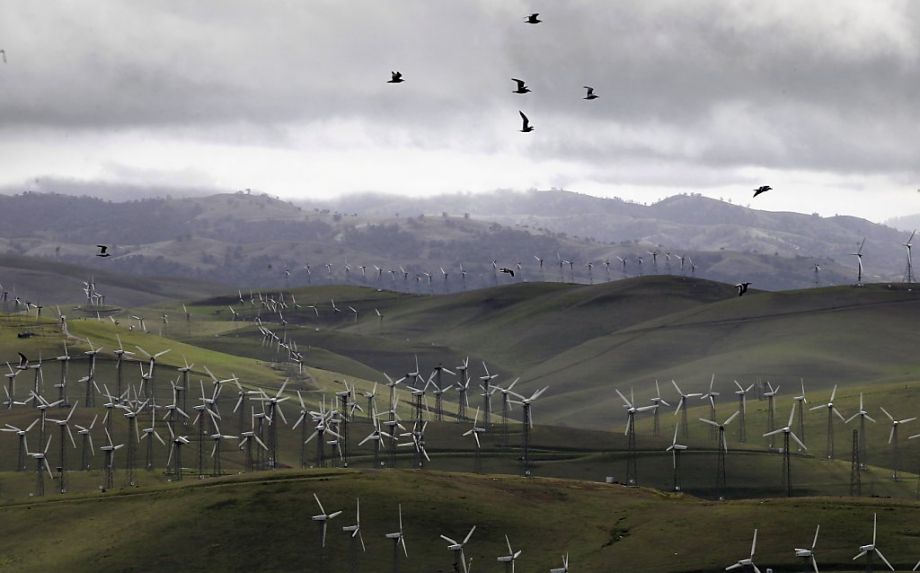
CK Vango
Scientists and engineers have made huge strides in mitigating bird deaths and win crucial support from bird conservation groups. Regulations have been enacted banning the construction of wind farms near migratory bird routes.Wind turbine technology has also improved markedly. The turbines now sit atop solid concrete round towers which do not look to birds like appealing perches. In addition, it is thought future wind farm development will be redirected offshore, where birds fly much more rarely. Studies show that offshore wind farms pose a reduced risk to birds.
Though these efforts have certainly reduced bird deaths related to wind farms, they cannot be completely eliminated. A comprehensive 2013 study by the Canadian Wildlife Service estimated about 23,000 birds were killed by wind farms a year.

Wikipedia
While tragic, this compares quite favourably with the number of bird deaths related to other human activities. Environment Canada estimated 200 million birds were killed by cats in this country. 25 million by hitting power-lines, 25 million by hitting buildings, 14 million by hitting vehicles, 5 million from hunting, 2.7 million from pesticides, 2.2 million from agricultural mowing, 1.4 million from forestry and 220,000 hitting communications towers.
This means wind farms account for approximately 0.009% of the total birds killed by human activities in Canada. We should also factor climate change into the bird deaths argument. Our failure to adopt wind power will hasten climate change, and this will in all likelihood lead to the extinction of thousands of bird species. If one were to take a cost benefit analysis from the birds point of view, preventing this argument appears even more specious.
Climate Change
Since the actual running of the turbines contributes no greenhouse gases to the atmosphere, it is the construction, maintenance and eventual decommissioning of the turbines that contribute to emissions and ultimately climate change. So how much of a climate impact does building wind turbines have? And how effective are they at offsetting carbon from other sources of energy?
A 2006 study by Britain's Parliamentary Office of Science and Technology compared the carbon footprints of the various non-fossil fuel based forms of energy generation. Wind energy was found to be in a virtual dead-heat with nuclear power: offshore wind releasing 5.25 and onshore 4.64 grams of CO2 equivalent into the atmosphere per kWh while nuclear emitted approximately 5 grams. hydroelectric was close behind, ranging from 2 to 10 gCO2eq/kWh, but tidal, solar photovoltaic (PV) and biomass lagged well back: they ranged from 25 to 80 gCO2eq/kWh. Though of course all of these are still several orders of magnitude better than the fossil fuels.
For wind, 98% of the carbon emissions released are during the manufacturing and construction process. The tower and foundations are made of steel and concrete while the rotors are made of fiberglass, all materials that are fairly carbon-intensive to manufacture. Once the turbine is erected the other 2% is accounted for by the regular maintenance trips to the turbines, for any spare parts, and then the eventual decommissioning of the turbine after 20 years. Offshore turbines emit slightly higher emissions since, though the manufacturing techniques are largely the same as onshore, more concrete is required for the foundations. Wind then is one of our best options for electricity generation in a carbon-constrained world, better even than solar.
A Problem of Scale
One may be surprised to see wind's carbon emissions in such a close tie with nuclear power. After all, the construction of nuclear facilities, the mining and refining of nuclear fuel and then dealing with the waste undoubtedly emits substantial amounts of carbon emissions. This can be explained by the differences in scale. Just a few tons of nuclear fuel can create tremendous amounts of electricity and run a 1,000 MW reactor for months or even years.
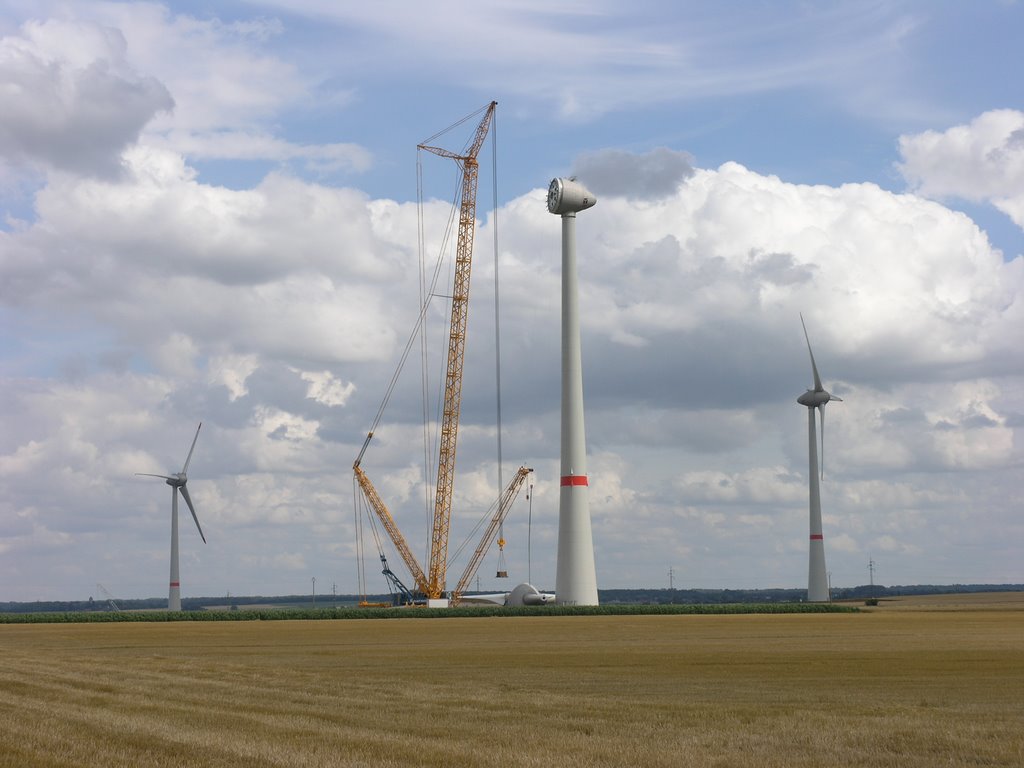
Steenki
Individual wind turbines are tiny by comparison: the standard size in the world is 2 MW, though 2.5 MW and 5 MW models are becoming more widespread, and a 7 MW turbine is being deployed. Keep in mind even the smaller turbines are very large: the Spanish 2 MW Gamesa G87 is fairly average, standing as high as 142.5 meters, and weighing up to 350 tons. There is enough steel in one of these turbines to manufacture over 200 automobiles.
We must also take into account the capacity factor. Because of the intermittency of the wind, a wind farm has an annual capacity factor of around 30-40%, that is, the farm produces only about 30-40% of its actual rated power throughout the year. Nuclear power plants, like fossil fuel plants, can essentially run 24/7/365 except for periodic maintenance or equipment failures. That means they have a capacity factor of around 90% and therefore a 1,000 MW-rated nuclear power plant will actually produce two and a half to three times more power than a 1,000 MW-rated wind farm in a year.
Depending on the capacity factor then, we can conclude that anywhere from 1,175 to 2,250 2 MW wind turbines will be needed to replace that single reactor. This many wind turbines will require a large area of land because the turbines need to be spaced far enough apart that there is no interference (turbulence) between the turbines. Turbines are generally spaced 5-10 turbine diameters apart. Now the problem of scale is beginning to become apparent.

Mastec
If wind is to start actually making a sizable contribution to global electricity production and begin to unseat fossil fuels it will require many thousands of wind farms and hundreds of thousands, or even millions, of massive wind turbines across the world. Scientists at the IPCC maintain that we must reduce our carbon footprint by at least 80% by mid-century to avoid the worst effects of climate change. The size of this challenge cannot be overstated, nor can the urgency of our striving to confront it. Meeting these targets with renewables will mean a building programme of such magnitude and speed it will necessarily be one of the largest undertakings in human history.
- Good, 2006.
- Watson, 2013.
- Rourke, 2013.
- Sourcewatch, “Waubra Foundation.”
- Acoustical Society of America, 2010.
- CanWEA, "Wind Turbine Sound and Health Effects: An Expert Panel Review," 2011.
- Chapman, 2011.
- Doyle, 2006.
- Kennedy, 2005.
- Daley, 2011.
- Lacey, 2011.
- Canwest News Service, 2006.
- Canadian Press, 2011.
- Grover, 2011.
- Banse, 2011.
- Rittler, 2005.
- Fairley, 2007.
- Zimmerling, Pomeroy, d’Entremont, & Francis, 2013.
- CBC News, 2013.
- Parliamentary Office of Science and Technology, 2006.
- Gamesa Corporation, "Gamesa G87 – 2 MW Product Brochure."
- British Wind Energy Association, "Blowing away the myths."
- Nuclear Energy Institute, "U.S. Nuclear Plants Statistics."
- National Renewable Energy Laboratory, "Wind Farm Area Calculator."
- Power-technology, global power industry news, "Roscoe Wind Farm, USA."
Politics
- Political support for wind is growing as a means to reduce greenhouse gas emissions.
- Governments are promoting wind power with tax incentives and Feed-In Tariffs.
- Wind turbine manufacturers are growing rapidly and becoming politically powerful.
The politics surrounding wind power are similar to some of the other second generation renewables. Interest in all of them is propelled by the desire of many governments to find an alternative to fossil fuels. A number of reasons can be listed for this shift: fossil fuels are the primary driver of global climate change, they are finite resources that will be depleted, many countries are worried about the security risks of relying upon imported fossil fuel and the volatility in the price of oil.
Many governments have mandatory renewable energy targets which determine how much energy must be generated by renewable sources. The British, Chinese and American governments have announced plans to generate 15% of their electricity from renewable sources by 2020. Canada already gets 63% of its electricity from renewable resources (primarily hydro) and has no national target. Nine provinces do however. British Columbia hopes to reach 93% renewable energy by 2020. Currently B.C. generates 86.3% of its power from renewable sources, most of which is hydroelectric power, a first generation renewable technology.
In fulfilling these new mandatory targets, governments are increasingly promoting second-generation renewable technologies with tax incentives or Feed-In Tariffs. Thanks in part to this government support 35% of all new generating capacity in the U.S. since 2005 was wind, greater than coal or gas.
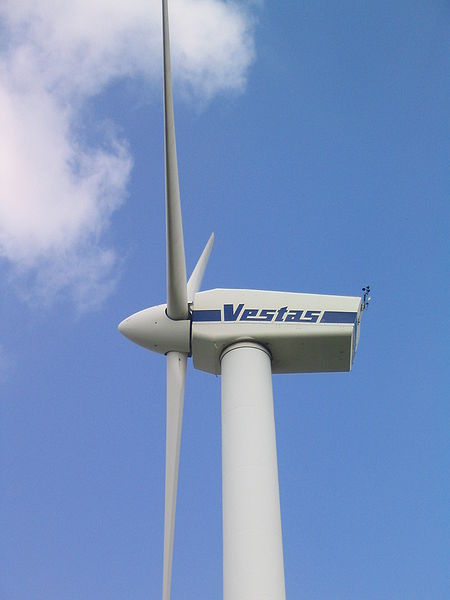
Steenki
Primarily it's the economics of wind power that is fueling its rapid growth in world power generation. Unlike solar, geothermal or tidal, wind is already cost-competitive with fossil fuel-based forms of electricity generation even without government subsidy, and oftentimes it’s the cheapest option available.
In the past decade this form of energy has benefitted from the development of an economy of scale. There are now massive Danish (Vestas), German (Enercon), American (GE Wind Energy) and Chinese (Sinovel and Goldwind) firms rapidly expanding and bidding for contracts to build wind farms all over the world.41 Canada purchases most of its wind turbines from Vestas, Enercon and GE, though turbine manufacturers are starting to appear in Ontario. The other second-generation renewable technologies have yet to fully mature and will likely see large gains in efficiency and economics in the years ahead. Until this happens, wind energy is likely to continue to dominate the renewables market.
Around the World
- Wind turbines were developed in Denmark and the United States in the 1970s and 1980s.
- Since 2000 wind power capacity has been expanding at breakneck speed, with 468 GW of installed capacity by 2016.
- Much of this growth has come from China which now has 42% of the world's wind turbines.
From 1900 to 1973 small wind turbines were used to generate tiny amounts of electricity in remote locations. Governments and businesses in Denmark and the United States experimented with larger wind turbines for power generation but investors showed little interest in the technology. In 1973 the Arab oil embargoes shocked the Western World and prompted a surge of interest in finding fossil fuel alternatives. Just as this event triggered the rise of France’s nuclear power industry and Germany’s solar power industry, the oil shocks kick-started wind power. Several departments of the United States government including NASA, the National Sciences Foundation (NSF) and the Department of Energy (DOE) combined funding to experiment with a number of wind turbine designs during the 1970s and 1980s.
These first utility-scale wind turbines came in a variety of two and three bladed designs and were revolutionary in their day, though small, inefficient and primitive by 21st Century standards. The world`s first wind-farm, the MOD-2 cluster of turbines, built by Boeing, was completed in Washington in 1981. The cluster could produce a record-breaking output of 7.5 MW. This site was dismantled in 1986 after its five year test period, which was considered a huge success by project managers.

Wikipedia
These modest beginnings laid the groundwork for modern wind turbine design. They allowed engineers to begin to address many of the problems of intermittency, wind speed changes, gearbox design and aesthetics, proving wind power could one day be economically competitive with fossil fuels.
Wind power's development stalled during the 1990s when fossil fuel prices sank again, undercutting its economic competitiveness. In 1996 America's largest wind turbine producer, Kenetech, went bankrupt.
In the past 15 years wind power has taken off again. Installed capacity of wind turbines has grown more than 30-fold in the past 16 years. In 1999 wind turbines were worth 13.6 GW of power; in 2016 that number is now 468 GW, meeting around 3% of the world`s electricity needs. Industry groups like the Global Wind Energy Council believe that generating capacity could reach 2,000 GW by 2030, supplying 17-19% of the world’s electricity.
These aren’t pie in the sky numbers. In almost year since 2000 more wind power capacity has been installed than the year before. The new record set in 2015 was 63 GW, up from 40 GW in 2010 and 11 GW in 2005. Most of the development has been concentrated in developed countries and China, so it seems likely interest in wind power will grow in the rest of the developing world too.
USE GRAPH INSTALLED CAPACITY http://www.gwec.net/wp-content/uploads/vip/GWEC-PRstats-2015_LR.pdf
Wind power is well-suited geographically for Europe and the United States, both global leaders in the industry since the 1990s. In the former case, the Baltic Sea basin and Spain's rugged topography are well suited for large offshore and onshore wind farms. Denmark leads the world in reliance upon wind power, producing 42% of its electricity from wind turbines. Germany, the world's fourth largest economy, has 40 GW of installed wind farms.
In the United States, the notoriously windy 'Tornado Alley' stretching north from the Texas Panhandle to Minnesota and Wyoming is an ideal location for widespread wind farm construction. In 2009 oil baron T. Boone Pickens proposed the Pickens Plan, a $1 trillion investment in hundreds of thousands of wind turbines along this north-south belt in order to generate 200 GW, or 20% of the United States electricity supply by 2020. As of 2016 however this dream appears far from being realized, with wind accounting for 75 GW and 4.5% of electricity generation. The Pickens Plan appears to have shifted its focus from wind power to natural gas development.
28 states currently have wind farms and much of the development has been dependent upon the continuation of a Production Tax Credit which congress extended for five years in 2015, a move that is expected to contribute to 19 GW more power by 2020.
The United States also has tremendous potential for offshore wind generation which has the added bonus of being in close proximity to its electricity-hungry coastal areas, though none of these have yet been developed.
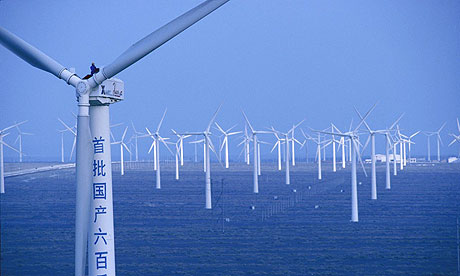
Daily Tech
China surpassed the United States in installed wind capacity in 2011, and in 2016 boasts 145 GW of power, doubling the American total. This unparalleled expansion has astonished experts as it represents a 100 fold increase in a decade. In 2014 the People’s Republic doubled its 2020 goal to 200 GW, and looks set to achieve it. This growth has stemmed from Chinese government policies mandating that all renewable energy produced must be purchased by grid operators, as well as large subsidies to wind turbine manufacturers and operators. China's long coastlines and giant windswept plains helped too. Despite this massive growth in wind power, it's still only 3.3% of China's electricity mix and China's coal-fired power plant sector is growing almost as quickly.
Other countries around the world are adopting wind energy at a rapid pace, and now over 100 countries have wind farms. India has a large and expanding fleet of wind turbines. Wind farms are being built in Latin America, Africa and the Middle East. Following the Fukushima nuclear accidents in March 2011 Japan’s prime minister stated his country intends to move decisively towards renewable energies, specifically wind, and away from nuclear power in the decades ahead, though by 2015 they were still lagging with only 3 GW of power.

Wikipedia
Canada
- Canada has been expanding wind power considerably in recent years.
- Ontario, Quebec and Alberta are the leaders, with Quebec having especially favourable geography for wind power.
- The Ontario government's support for wind power has partially contributed to a massive rise in electricity prices.
Canada currently has the 7th most installed wind capacity in the world. That’s 11 GW worth, around 5% of Canada's total electricity demand. This is impressive for a country that had almost no wind farms at all fifteen years ago and in some senses was a relative latecomer to the wind game. Since then Ontario, Quebec, and Alberta have emerged as the leaders of Canada's wind industry with 4,361, 3,262 MW and 1,500 MW of generating capacity respectively. As in the rest of the world, generating capacity of wind power is set to grow rapidly, especially in Ontario and Quebec.
Geographically, Canada is well suited for wind power. The windswept belt that stretches across America's central plains extends into Canada's Prairie Provinces, and is a large part of the reason Alberta has a number of small wind farms. This does not explain Saskatchewan’s lukewarm interest in wind and despite its similar windy conditions only has about 15% of the wind capacity of Alberta.
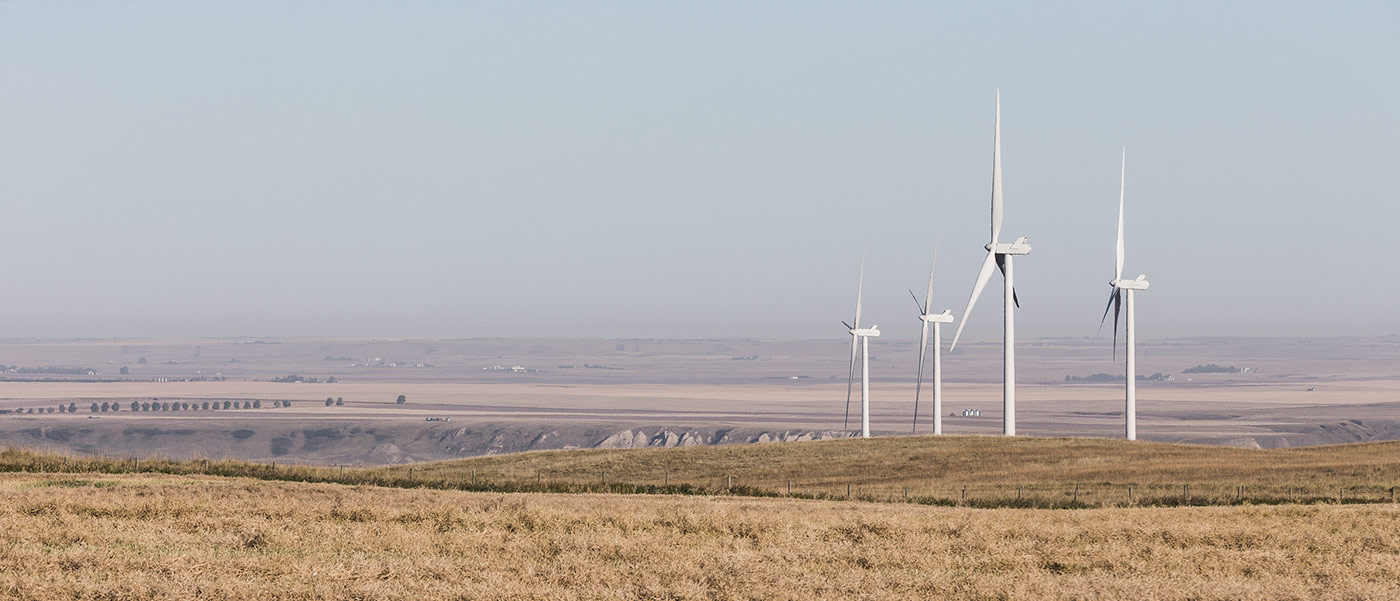
Enbridge
Quebec has been referred to as the "Saudi Arabia of Wind" by a spokesperson of the Canadian Wind Energy Association. The potential for wind farm developments there are huge. Quebec has typically relied upon hydroelectric dams for the bulk of its electricity needs, but with most of the province's best hydroelectric potential already tapped out by the province's eight million residents, the government has turned to wind farms for future generation capacity. The Gaspe Peninsula in particular is seen as having the most potential for large-scale wind farms, while in the sparsely populated north many communities are considering small-scale wind farms to fulfill their electricity demands.
Geographically, the Maritimes are blessed with an abundance of wind, and in the past decade a number of small wind farms, ranging in size from a single turbine to 44 at Prince Edward Island's West Cape 2 farm, have been built. These smaller wind turbines go a long way to satisfying the smaller electricity demands of these provinces: wind energy accounts for 18% of P.E.I.'s electricity demand. By 2013 that number is projected to rise as high as 30%, one of the highest rates in the world for any jurisdiction.
The Case of Ontario
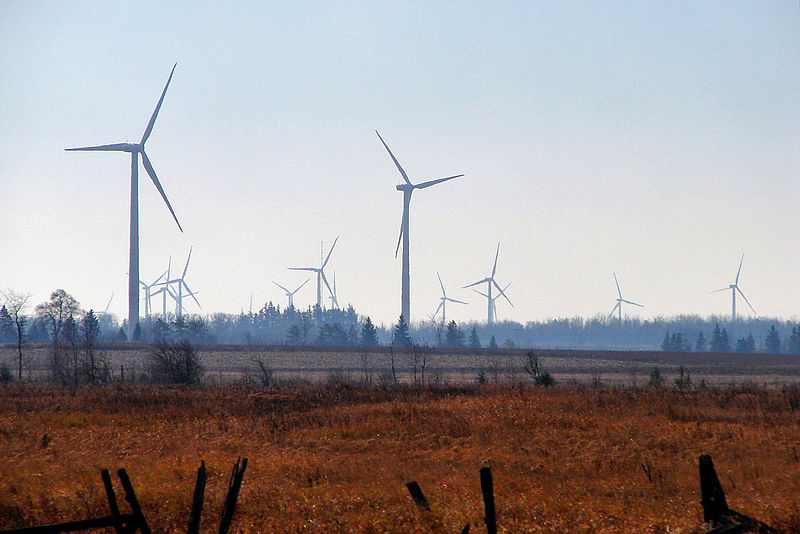
Wikipedia
Further east, Ontario's government has been undertaking aggressive economic policies aimed at reducing the province's carbon footprint, the cornerstone of which was the Green Energy and Green Economy Act of 2009. That legislation phased out coal-fired power plants and replaced their electricity capacity with a smorgasbord of cleaner natural gas and renewables, especially wind. The Niagara Escarpment in Southern Ontario is subjected to strong and constant winds and has been the site of all Ontario's wind farms to date. Wind farm installations peaked in 2015 at around 1,400 MW and are expected to hit about 1,000 MW in 2016. In 2017 new farm installations are expected to drop off to almost nothing as the province’s Feed-In Tariff expires.
These wind power investments have had a major stimulating effect on Ontario’s depressed manufacturing economy, with many of the new turbines being manufactured in the province. A study by Compass Renewable Energy Consulting projected out to 2030 that 73,000 people would be employed directly or indirectly in the wind power industry, adding $7 billion to the province’s GDP and prompting $14 billion in business investment. It is thought that by developing an indigenous wind power industry these last few years, Ontario can insert itself into the global supply chain for wind turbine components and continue to derive economic benefits from the wind industry for years to come.
Development of wind power has been a hotly contested issue in Ontario, especially as the rates paid by Ontarians for electricity have gone up dramatically and become some of the highest in North America. The Green Energy and Green Economy Act appears to have been at least partially the culprit. The provincial government locked itself into hugely expensive long term contracts with independent power providers who built wind farms. Since those contracts were signed the price of wind power has come down dramatically but the government is unable to renegotiate the contracts, leaving taxpayers to give largely pointless subsidies to independent power producers, some of whom operate wind turbines.
If Ontario is to continue its dramatic wind development it will need to get control of its spiralling electricity prices. A recent study by the Ontario Chamber of Commerce found that 1 in 20 businesses were considering leaving the province for somewhere where the electricity is cheaper. A poll by Leger found that 81% of Ontarians thought high electricity prices posed a threat to the economy.
Other jurisdictions have managed the integration of wind without exploding utility bills. Germans have cheaper electricity bills than most places in North America and support for the transition to a post-fossil fuels economy, the Energiewende, remains sky-high. Yet on some days they get as much as 75% of their power from renewables. On a windy day in July 2015 Denmark generated 140% of its electricity demand from wind power, yet electricity costs are around 13 cents per KWh, some of the lowest in the EU.
The Canadian Wind Energy Association is aiming for wind power to produce 20% of the country's energy by 2025. In order to reach this goal the total installed capacity has to increase to 5.5 times by that time.
- CanWEA, "Installed Capacity", 2015.
- Wikipedia, "List of wind farms in Canada."
- Environment Canada, "Canadian Wind Energy Atlas."
- Government of Prince Edward Island, 2009.
- Legislative Assembly of Ontario, 2009.
- Canadian Wind Energy Association, “Wind Dividends: An analysis of economic impacts from Ontario’s wind procurement,” 2015.
- CBC News, 2015.
- Taber, 2015.
- Morris, 2015.
- Kroh, 2014.
- Eurostat, 2015.
- Nelsen, 2015.
- Nelsen, 2015.
- Canadian Wind Energy Association, "Windvision 2025: Powering Canada's Future."
British Columbia

Vancouver Sun
- B.C. was the last province to build a wind farm but now has five totalling 488 MW.
- The best locations for wind farms are in the Peace River region in the province's northeastern corner, and the northern part of Vancouver Island.
- The Canadian Wind Energy Association has identified sites that could generate 5,250 MW of power at reasonable rates.
If one were to examine Environment Canada's Wind Atlas, British Columbia's onshore wind energy potential stands above all the other provinces except Quebec. B.C. however was the last province to build a wind farm. Wind power development finally took off in BC following BC Hydro's Clean Power Call in 2008, which sought to spur utility investment by Independent Power Producers. The first wind farm opened in 2009 and in 2016 the fifth is under construction. Four are in the Peace River in the province’s northeast and one at the northern tip of Vancouver Island.

BC Hydro
The windswept Rocky Mountain foothills of the Peace Region are an ideal spot for wind farm development: 19 of the top 20 best sites for wind farms are in this region, according to a B.C. Hydro assessment. The region is also conveniently close to the major transmission lines that power the Peace River dams. The Peace is also sparsely populated, neutralizing most NIMBY-related objections to wind farms. Other regions meeting these criteria are northern Vancouver Island, the Okanagan and the Kootenays.
The first wind farm in BC was the Bear Mountain Wind Park built near Dawson Creek, featuring 34 Enercon turbines. At the Dokie Power Project opened in 2011, 48 Vestas V90 turbines generate 144 MW of power. The Quality Wind Project near Tumbler Ridge generates 142 MW while Port Hardy’s Cape Scott Wind Project generates 99 MW. There’s also one 1.5 MW turbine atop Grouse Mountain overlooking Vancouver. These all come to 488 MW of capacity, while the Meikle Wind Farm also near Tumbler Ridge will be the biggest yet at 185 MW. To put this value into context for B.C., in 2007 the province had 12,609 MW of capacity from hydroelectric dams and 2,223 MW from fossil fuels. All of the companies constructing these farms are B.C. based start-ups.
So far this amounts to a modest 1.6% of the province’s electricity demand. B.C. has a lot of room to grow wind's share. B.C. Hydro estimates the province has 16,425 MW of onshore wind potential. In the Canadian Wind Energy Association’s Wind Vision 2025: Strategy for British Columbia, they identified 5,250 MW of wind energy sites that could be harnessed for less than $105 per MW by 2025. This is only slightly more expensive than power from the Site C Dam. Fulfilling this Wind Vision would generate 7,500 person-years of long term employment, and triple that during the construction phase. This would provide a $3.7 billion boost to provincial GDP and $16 billion in business investment. B.C. could also benefit from the manufacturing skills derived from developing the wind vision. There’s already a small turbine manufacturer in Surrey, B.C., Endurance Wind Power, who sells its turbines for export across North America and in Europe.
A 2012 assessment by consulting firm GL Garrad Hassan found the price of wind in this province had been falling much faster than expected. Wind is now the cheapest renewable resource on offer in most contexts, significantly lower than B.C. Hydro’s own estimates.
Wind Farms in British Columbia (2016)
- Environment Canada, "Canadian Wind Energy Atlas."
- Wikipedia, “List of wind farms in Canada.”
- Wikipedia, “List of wind farms in Canada.”
- CanWEA, "2012 assessment of wind energy costs in B.C.", 2012.
- Alterra Power Corp., "Dokie Power Project, British Columbia."
- Wikipedia, “List of wind farms in Canada.”
- Centre for Energy, 2012.
- Canadian Wind Energy Association, "Windvision 2025: Powering Canada's Future."
- Energy Source Guides, “Large wind turbine businesses in Canada.”
- Advanced Energy Economy Institute, 2015.
Bibliography
To ensure continuity of material, all of the external web pages referenced here were cached over the course of research.
Readers are recommended to search the current links for any changes.
Acoustical Society of America. "Low Frequency Sound and Infrasound from Wind Turbines." Acoustical Society of America 159th Meeting Lay Language Papers. April 19, 2010. Cached May 30, 2012.
Advanced Energy Economy Institute. "New report: Renewable energy and energy efficiency will grow, provide options for clean power plan compliance based on cost competitiveness." PR Newswire. June 22, 2015. Cached April 11, 2016.
Altagas. "Bear Mountain Operations Summer 2010." Cached March 23, 2012.
Alterra Power Corp."Dokie Power Project, British Columbia." Cached March 23, 2012.
American Wind Energy Association. "Economics of Wind Energy." Cached March 23, 2012.
Banse, Tom. "Poll: Support for wind energy remains strong in Northwest." NPR. January 7, 2011. Cached March 23, 2012.
BC Citizens for Green Energy. "How wind can supply B.C. with clean, renewable electricity." Cached March 23, 2012.
B.C. Government. "British Columbia: Climate Action for the 21st Century Work Book." Cached March 23, 2012.
BC Hydro. "Selected Proposals." Clean Power Call. Cached March 23, 2012.
Boeing. "MOD-2/MOD-5B Wind Turbines." Cached March 23, 2012.
British Wind Energy Association. "Blowing away the myths." Cached March 23, 2012.
Caltech Press Release. "Wind-turbine Placement Produces Tenfold Power Increase, Caltech Researchers Say." Cached March 23, 2012.
Canadian Geographic. "Small-Scale Wind." Cached March 23, 2012.
Canadian Press. "Moratorium on off-shore wind farms in Ontario." Feb. 11, 2011. Cached march 23, 2012.
Canadian Wind Energy Association. "2012 assessment of wind energy costs in B.C." 2012. Cached April 11, 2016.
Canadian Wind Energy Association. "Wind Dividends: An analysis of economic impacts from Ontario’s wind procurement." November 3, 2015. Cached April 11, 2016.
Canadian Wind Energy Association. "Wind Turbine Sound and Health Effects: An Expert Panel Review." 2011. Cached March 23, 2012.
Canadian Wind Energy Association. "Installed Capacity." December 2015. Cached April 10, 2016.
Canadian Wind Energy Association. "Windvision 2025: Powering Canada's Future." Cached May 30, 2012.
Canadian Wind Energy Association. "Wind Vision 2025: A strategy for British Columbia." Cached April 11, 2016.
CanWest News Service. "Ontario wind farms creating huge gusts of opposition." September 2, 2006. Cached March 23, 2012.
Canwest News Service. "Quebec moves to forefront of Canada's rapidly growing wind industry." July 29, 2007. Cached March 23, 2012.
CBC News. "9 leading causes of bird deaths." October 1, 2013. Cached April 11, 2016.
CBC News. "Ontario sees hydro rates jump – again." November 1, 2015. Cached April 10, 2016.
Centre for Energy. "BC Energy Facts and Statistics." Cached March 23, 2012
Chapman, Simon. "Much Angst over wind turbines is just hot air." Sydney Morning Herald. December 21, 2011. Cached May 30, 2012.
Chinchilla, Rigoberto. "Wind Power Technologies: A Need for Research and Development in Improving VAWT's Airfoil Characteristics." Journal of Industrial Technology. Volume 27, Number 1 – January through March 2011.
Daley, Beth. "Wampanoag tribe sues over Cape Wind." Boston.com. July 11, 2011. Cached March 23, 2012.
Danish Energy Agency. "Vindturbines In DK." p.5.
The Diane Rehm Show. "Wendy Williams and Robert Whitcomb: Cape Wind Radio Show." May 7, 2007. Cached March 23, 2012.
Doyle, Tim. "Koch's New Fight." Forbes. September 21, 2006. Cached March 23, 2012.
The Economist. "Wind of Change." Dec. 4, 2008. Cached March 23, 2012.
Energy Source Guides. "Large wind turbine businesses in Canada." Cached April 11, 2016.
Energy Source Renewable. "Renewable Energy Source: Debate on The Wind Energy Challenge." Cached on March 23, 2012.
Environment Canada. "Canadian Wind Energy Atlas." Cached March 23, 2012.
European Wind Energy Association. "Wind Energy--The Facts: The Economics of Wind Power." Cached March 23, 2012.
Eurostat. "Electricity Price Statistics." October 2015. Cached April 10, 2016.
Fairley, Peter. "Massive offshore wind turbines safe for birds." MIT Technology Review. February 12, 2007. Cached March 23, 2012.
Gamesa Corporation. "Gamesa G87 – 2 MW Product Brochure." Cached March 23, 2012.
Gamesa Corporation. "Gamesa Corporation Press Release: Eleven Spanish companies join forces on Azimut Project to develop a 15-MW offshore wind turbine using 100% Spanish technology." Cached March 23, 2012.
Gillam, Carey. "Quietly, wind farms spread footprint in U.S." Reuters. May 19, 2008. Cached March 23, 2012.
Global Wind Energy Council. "Global Cumulative Installed Wind Capacity 1996-2010." 2011. Cached March 23, 2012.
Global Wind Energy Council. "Global Installed Wind Power Capacity (MW)." 2016. Cached Jan 1, 2016.
Global Wind Energy Council. "Global Wind Energy Outlook: 2000 gigawatts by 2030." 2014. Cached April 10, 2016.
Global Wind Energy Council. "Global Wind Statistics 2016." February 10, 2016. Cached April 10, 2016.
Global Wind Energy Council. "Wind in Numbers." 2015. Cached April 10, 2016.
Good, Justin. "The Aesthetics of Wind Energy." Human Ecology Review. Vol. 13, No. 1, 2006. Cached March 23, 2012.
Government of Canada. "Canada's Action on Climate Change." Renewable Energy and Distributed Generation Task Force. Cached March 23, 2012.
Grover, Sami. "NIMBYs in Minority? Many Residents Welcome Massive Turbines." Treehugger. January 5, 2011. Cached March 23, 2012.
Government of Prince Edward Island. "Island Wind Energy: Securing Our Future, the 10 point plan." 2009. Cached May 30, 2012.
Jacobsen, Henriette. "Denmark breaks its own world record in wind energy." Euractiv. January 15, 2016. Cached April 10, 2016.
Jacobson, Mark. & Delucchi, Mark. "A Plan to Power 100% of the Planet with Renewables." Scientific American. October 26, 2009. Cached March 23, 2012.
Johnson, Keith. "Offshore Winds: Plenty of Potential, Even More Hurdles." Wall Street Journal. April 3, 2009. Cached March 23, 2012.
Kennedy, Robert F. Jr. "An Ill Wind Off Cape Cod." New York Times. December 16, 2005. Cached March 23, 2012.
Kroh, Kiley. "Germany sets new record, generating 74% of power needs from renewable energy." Climate Progress. May 13, 2014. Cached April 10, 2016.
Krohn, Soren. "The Economics of Wind Energy: A Report by the European Wind Energy Association." Cached March 23, 2012, p. 64.
Lacey, Stephen. "NIMBYism kills 45% of clean energy projects." Clean Technica. October 24, 2011. Cached April 11, 2016.
Laumer, John. "Common Eco-Myth: Wind Turbines Kill Birds." Treehugger. April 6, 2006. Cached March 23, 2012.
Layton, Julia. "Do Wind Turbines Kill Birds?" How Stuff Works. Cached March 23, 2012.
Legislative Assembly of Ontario. "Bill 150, Green Energy and Green Economy Act of 2009." Cached March 23, 2012.
Morris, Craig. "German power bills are low compared to US average." Energy Transition. May 26, 2015. Cached April 10, 2016.
National Renewable Energy Laboratory. "Wind Farm Area Calculator." Cached March 23, 2012.
Nelsen, Arthur. "Wind power generates 140% of Denmark’s electricity demand." The Guardian. July 10, 2015. Cached April 10, 2016.
NRG: Bluewater Wind. "Wind Energy: World's Fastest Growing Energy Supply." Cached March 23, 2012.
Nuclear Energy Institute. "U.S. Nuclear Plants Statistics." Cached March 23, 2012.
Oddie, Will. "Small scale wind or solar more economical? It’s no contest." The Western Producer. March 8, 2013. Cached April 10, 2016.
Pickens Plan. "The Plan." Cached April 10, 2016.
Pierport, Nina."Wind Turbine Syndrome. A report on a natural experiment."
Power-technology, global power industry news. "Roscoe Wind Farm, USA." Cached March 23, 2012.
Quick, Darren. "Wind turbine placement to optimize wind power generation for a given area." Gizmo Magazine. July 23, 2011. Cached March 23, 2012.
Ragheb, M. "Wind Turbines in the Urban Environment." University of Illinois Netfiles. Cached Marh 23, 2012.
Randall, Tom. "What just happened in solar is a bigger deal than oil exports." Bloomberg News. December 17, 2015. Cached April 10, 2016.
Renewable Energy Focus. "WWEA: 100 countries now using wind power." May 16, 2013. Cached April 10, 2016.
Renewable Power News. "Solar Power Efficiency is Improving – Time to get off the fence." April 15, 2010. Cached March 23. 2012.
Renewableenergyworld.com. "BTM Forecasts 340 GW of Wind Energy by 2013." May 29, 2009. Cached March 23, 2012.
REN 21. "Renewables 2007, Global Status Report." 2007. Cached March 23, 2012.
Reuters. "China became top wind power market in 2009: Consultant." March 29, 2010. Cached March 23, 2012.
Rittler, John. "Wind turbines taking toll on birds of prey." USA Today. January 4, 2005. Cached March 23, 2012.
Rochester Solar Technologies. "Wind Turbine Information: About Wind Turbines." Cached March 23, 2012.
Rourke, Alison. "Windfarm sickness spreads by word of mouth, Australian study finds." The Guardian. March 15, 2013. Cached April 11, 2016.
Shahan, Zachary. "Cost of wind power – kicks coal’s butt, better than natural gas." Clean Technica. May 1, 2011. Cached April 11, 2016.
Simply Renewable Energy Products. "Small Scale Wind Turbine." Cached March 23, 2012.
Sneiderman, Phil. "New study yields better turbine spacing for large wind farms." John Hopkins University Gazette. January 18, 2011. Cached March 23, 2012.
Sourcewatch. "Waubra Foundation." Cached April 10, 2016.
Steel, William. "Siemens looks toward next-generation 10-20 MW wind turbines." Clean Technica. September 15, 2015. Cached April 10, 2016.
Taber, Jane. "Skyrocketing electricity rates may force one in 20 Ontario businesses to close." The Globe and Mail. July 8, 2015. Cached April 10, 2016.
Thomas, Justin. "New Record: World's Largest Wind Turbine (7+ Megawatts)." Metaefficient: Guide to Efficient Living. Cached March 23, 2012.
Vuong, Andy. "Tycoon's plan taps wind." Denver Post. July 11, 2008. Cached March 23, 2012.
U.K. Government. "Carbon Footprint of Electricity Generation." Parliamentary Office of Science and Technology. October 2006. Cached March 23, 2012.
U.S. Census Bureau. "Number of homes." 2012. Cached March 23, 2012.
U.S. Department of Energy. "2014 Wind technologies market report." August 2015. Cached April 11, 2016.
US Department of Energy. "Wind and Water Power Program." Cached March 23, 2012.
U.S. Department of Energy. "Wind Turbines go Super Sized." Energy Efficiency and Technology. 2011. Cached March 23, 2012.
Watson, Rebecca. "The "Science" of wind turbine syndrome." Popular Science. October 25, 2013. Cached April 11, 2016.
Wikipedia. "List of wind farms in Canada." Cached April 10, 2016.
Xinhua. "China’s new wind power capacity rises 60%, hits record high." March 2, 2016. Cached April 10,2016.
Zimmerling, R., Pomeroy, A., d’Entremont, M. & Francis, C. "Canadian estimate of bird mortality due to collisions and direct habitat loss associated with wind turbine developments." Aviation Conservation and Ecology. 8 (2): 10. 2013. Cached April 11, 2016.
